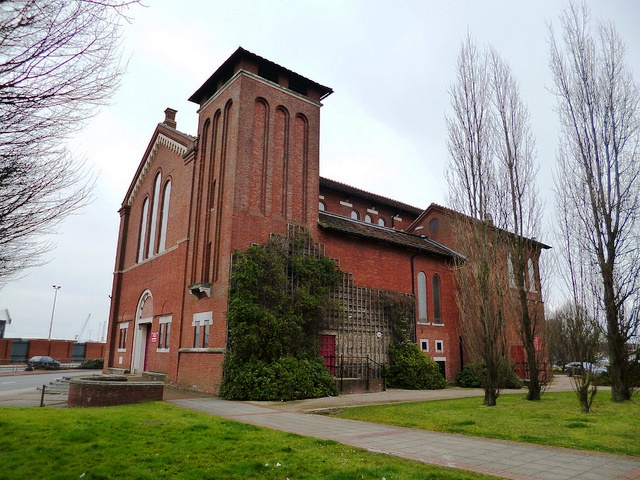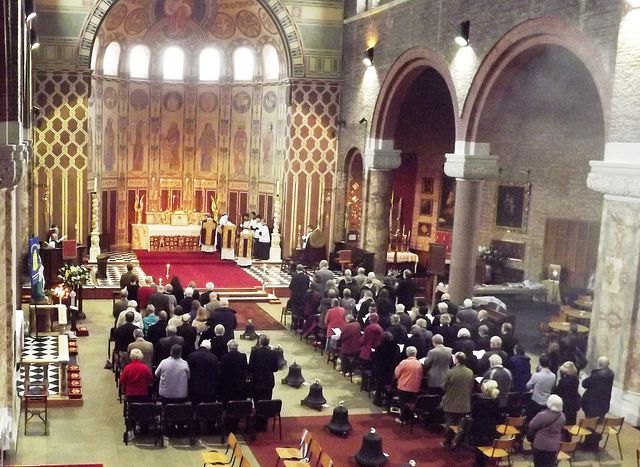Construction
Originally, the site had a small mission church situated in an area of extreme deprivation. The church was built because of the efforts of Father Robert William Radclyffe Dolling, an Irish Anglo-Catholic priest. He worked to alleviate the social ills of the area. At the same time, he collected donations from the residents of Old Portsmouth to build a new church.
The formal opening of the church took place on 27 October 1895 with a ceremony involving mass being said at the old mission church followed by a procession to the new church, but the nature of the ritual led to a row with the Bishop of Winchester.
Establishment

Dolling’s successor, Father Tremenheere, continued to decorate the interior until 1914 when another long-serving incumbent arrived. Work done during this time included the completion of the murals and the addition of a wooden pulpit. Tremenheere’s successor, Father C. W. Coles, was to serve the parish through two world wars until 1954 when the last service was held.
[The above description was an anonymous contribution.]

A Ring of Bells for the Ordinariate
St Agatha’s Church, Portsmouth, has had a chequered history. Founded in the nineteenth century as a high church “shrine”, it started life as part of the Church of England, although, some might argue, only just. During the Second World War, the locality, which is adjacent to the Naval dockyard, was a target for the Luftwaffe, but, whilst the majority of its parish was flattened, the church miraculously survived, albeit minus most of its glass. As a church in the middle of a devastated area, though, and lacking parishioners from the network of poor streets it was built to serve, St Agatha’s was abandoned by the C of E not many years later, in 1954.
For a long time its future looked grim. In the sixties the church that the bombers missed became in turn a target of the planners, who wanted to drive a multi-lane highway through the site. The church lost its Lady Chapel (unnecessarily, as the plans changed) but the rest once again somehow survived, and was used for a long time as a store for the Navy, until the St Agatha’s Trust took a lease from its owners, the Hampshire County Council, and returned it to ecclesiastical use in 1994, as the home of a group known as the Traditional Anglican Communion. Lovingly, the church was restored to the dignity of its former ritualistic existence. Earlier this year, the congregation and its clergy joined the Ordinariate of Our Lady of Walsingham.
For anyone who may be unfamiliar with this newly established body, it may be worth trying to explain a little about it. It isn’t any kind of breakaway group, but is part of the Roman Catholic Church, formed with the current Pope’s particular blessing, and made up largely of former members of the Church of England who want to be in full communion with the Universal Church, whilst retaining certain features of the Anglican tradition in their worship. About forty groups round the country have joined so far, under the leadership not of a bishop (it’s like a sort of non territorial diocese) but of an Ordinary, who is a former Anglican bishop, Monsignor Keith Newton.
These groups have mostly had to leave their buildings behind and worship at the local Catholic church, and so St Agatha’s is unusual in being a church specifically dedicated to the use of the Ordinariate. What’s more, it now has a ring of bells. Monsignor Newton commented in his homily at the dedication service for these bells, on Saturday 10th November 2012, that bells were a part of the unique Anglican “patrimony”, to use the Pope’s word, but a part that was not very portable. So St Agatha’s was particularly fortunate, and it is fitting, too, that bells should be installed in a church dedicated to the patron saint of bellfounders and ringers.
To anyone brought up on the Prayer Book, this service was both beautiful and, in the context, unexpectedly familiar. It was impossible not to speculate what the Dean of the nearby Catholic Cathedral, Canon David Hopgood, who was robed and present in the sanctuary, made of the sixteenth century English, and the intense dignity of the ritual, now unfamiliar in most modern Catholic churches. No doubt he charitably reasoned that it takes all sorts to make a church! The centrepiece of the service, of course, was the blessing of the eight bells, which stood in a line along the centre aisle. Each was sprinkled with holy water and censed inside and out, then decked with a white ribbon, recalling the white garment in a baptism, to signify that it will now ring for the glory of God.
The details of the bells, which it is hoped will be hung in the tower in time to be rung for St Agatha’s day in February, are as follows:

The dedication service, in which 18th Century French red silk velvet vestments were used
